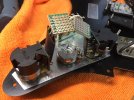You engineer types drive me crazy. I'm a strong proponent of 'just get the job done by the most expedient method'. 
//rant on
That's just fine, but.......
Some people enjoy the technology that goes into the tools of one's trade or hobby. If there weren't, there would never have been any progress or innovation over time in those tools of the trade. It took people who like to tinker endlessly to discover the right combination of wire, magnets, materials, etc to understand why and how different PUPs sound the way they do. There are endless other examples. Many of the people who made these things possible were not accomplished players. Where would this world be without the engineers?
For the person whose particular passion is playing, I can fully understand why their motto would be "gitter done!". Nothing wrong with that.
But why can't those people have a similar understanding of those who enjoy the process, science, or mechanics etc. of the instrument?
This is largely the reason behind the many totally bogus myths about guitars in general - the lack of interest to truly understand something.
I have no quarrel with anyone that doesn't care about those things, but it's not right to denigrate those people who do.
These same principles apply to just about everything, not just guitars, amps, etc.
There should be a National Engineers Day IMO.
//rant off




